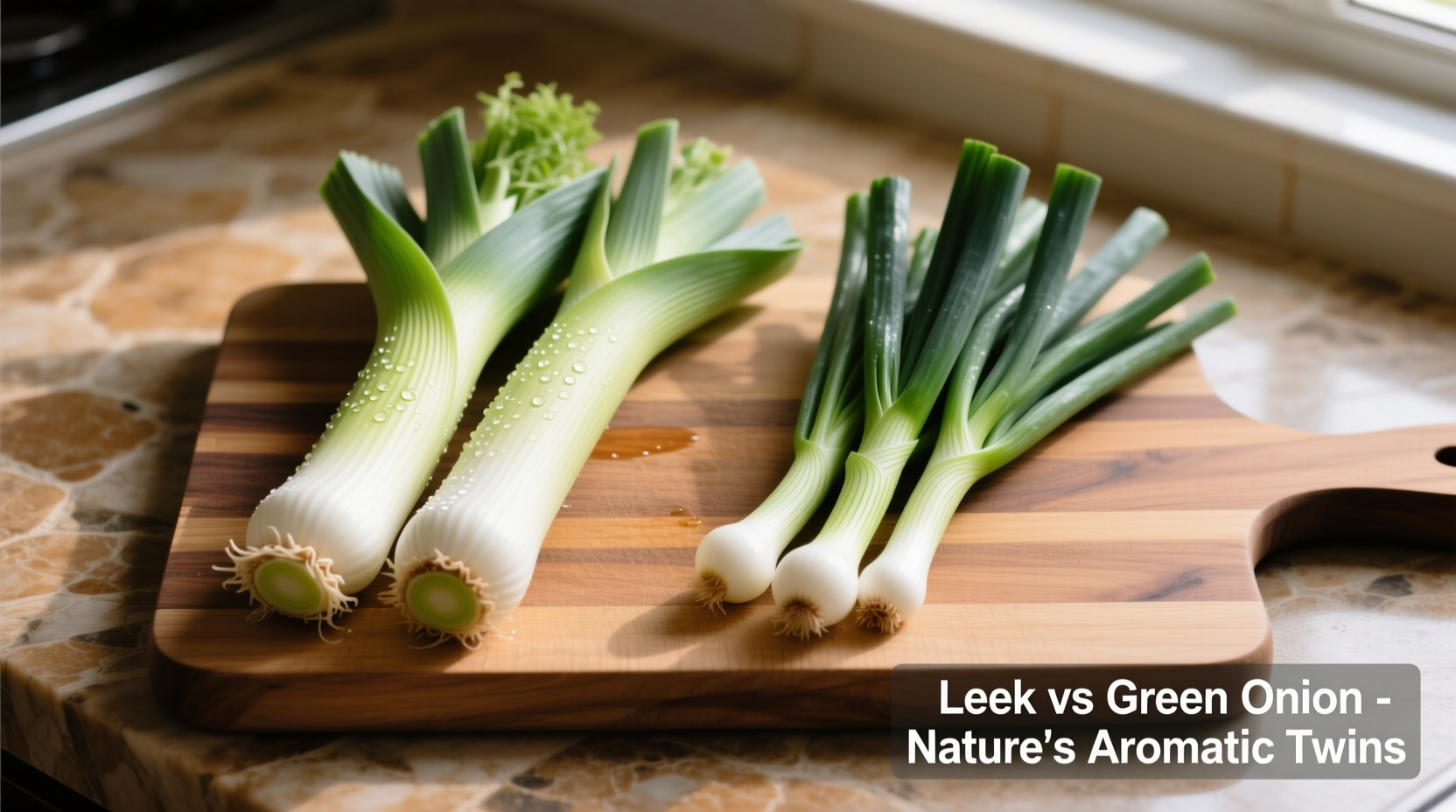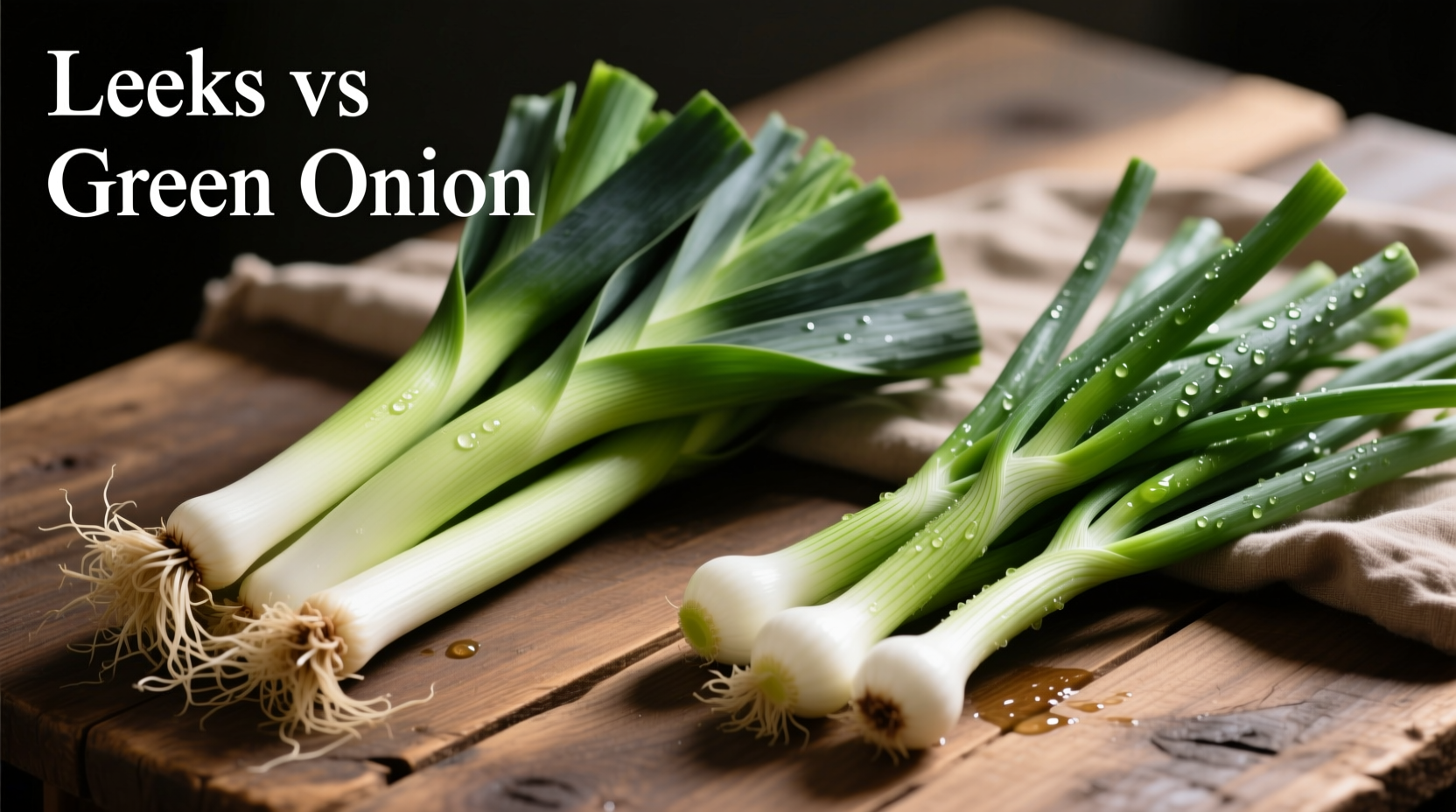Leeks and green onions are not interchangeable despite their similar appearance. Leeks offer a mild, sweet flavor ideal for slow-cooked dishes, while green onions provide a sharper bite perfect for garnishes. Understanding their structural differences—leeks have a solid cylindrical base versus green onions' hollow stems—is crucial for proper substitution in recipes.
Ever stood in the produce aisle confused by the slender green vegetables lined up side by side? You're not alone. Many home cooks mistakenly treat leeks and green onions as identical ingredients, only to discover their dishes miss the mark. As a professional chef who's worked with both ingredients daily for over 15 years, I've seen how this simple confusion can undermine otherwise perfect recipes.
| Characteristic | Leeks | Green Onions (Scallions) |
|---|---|---|
| Botanical Classification | Allium ampeloprasum var. porrum | Allium fistulosum |
| Flavor Profile | Mild, sweet, subtle onion essence | Sharper, more pungent onion flavor |
| Edible Parts | White and light green sections only | White bulb through dark green tops |
| Texture | Firm, layered structure | Hollow, cylindrical stems |
| Best Cooking Method | Slow cooking, braising, soups | Raw garnishes, quick sautés |
Visual Identification: Spotting the Difference at a Glance
While both feature long green stalks, their structural differences are unmistakable once you know what to look for. Leeks grow as a solid, cylindrical base that gradually transitions to flat green leaves—think of them as nature's layered tower. Green onions, by contrast, maintain hollow, tube-like stems from bulb to tip. The USDA Agricultural Research Service confirms these structural differences directly impact how each vegetable behaves during cooking processes.

Flavor Chemistry: Why Substitutions Fail
The flavor disparity stems from their distinct chemical compositions. Leeks contain lower concentrations of allyl sulfides—the compounds responsible for onion's characteristic bite—making them significantly milder. Cornell University's Food Science Department notes that leeks require approximately 30 minutes of cooking to develop their signature sweetness, while green onions' sharper flavor emerges almost immediately when heated.
When Substitutions Work (and When They Don't)
Context boundaries matter significantly in the leek vs green onion debate. In slow-cooked dishes like potato leek soup or braised meats, green onions will overpower the dish with their sharpness. However, in quick applications like salad garnishes or stir-fries, leeks lack the necessary punch. The exception? The white portion of green onions can sometimes replace leeks in soups when used in double quantity, but never substitute leeks for green onions in raw applications.
Proper Preparation Techniques
Cleaning methods differ substantially due to their structures. Leeks require careful slicing and soaking to remove trapped soil between layers—a step often overlooked by novice cooks. Green onions simply need a thorough rinse under running water. Professional chefs at the Culinary Institute of America emphasize that improperly cleaned leeks remain one of the most common kitchen mistakes, potentially ruining an otherwise perfect dish.
Storage Science: Maximizing Freshness
Understanding their different storage needs prevents unnecessary waste. Leeks maintain freshness for 10-14 days when wrapped in damp paper towels inside a perforated plastic bag in the refrigerator's crisper drawer. Green onions last slightly longer—up to 2 weeks—when stored upright in a glass of water with a plastic bag loosely covering the greens. This storage method, validated by UC Davis' Postharvest Technology Center, keeps green onions crisp by mimicking their growing conditions.
Signature Dish Applications
Each vegetable shines in specific culinary contexts. Leeks form the flavor foundation in French potage parmentier and Scottish cock-a-leekie soup, where their sweetness develops through slow cooking. Green onions star in Asian cuisine—think of the vibrant garnish on Japanese ramen or the essential component in Chinese scallion pancakes. Attempting to swap them in these signature dishes fundamentally alters the intended flavor profile.
Common Mistakes to Avoid
Many home cooks make these critical errors: using the entire leek (including tough green tops) without proper preparation, substituting green onions 1:1 for leeks in cooked dishes, or using leeks raw where green onions would provide necessary brightness. Remember that the dark green portion of leeks, while often discarded, can be simmered to make flavorful vegetable stock—a technique documented in traditional French culinary texts dating back to the 18th century.
Practical Recipe Guidance
For beginners, try these foolproof applications: slice leeks thinly for quiches where their mild flavor complements eggs beautifully, or use green onions as the aromatic base in stir-fries where their quick-cooking nature preserves their crisp texture. When substituting in a pinch, use 1 cup of finely sliced green onions for every 1/2 cup of leeks in cooked dishes, but never attempt the reverse substitution in raw applications.











 浙公网安备
33010002000092号
浙公网安备
33010002000092号 浙B2-20120091-4
浙B2-20120091-4